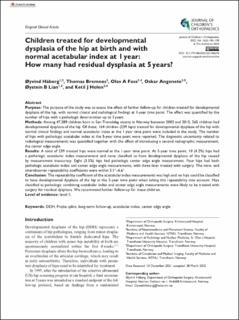| dc.contributor.author | Håberg, Øyvind | |
| dc.contributor.author | Bremnes, Thomas Alexander | |
| dc.contributor.author | Foss, Olav A. | |
| dc.contributor.author | Angenete, Oskar W | |
| dc.contributor.author | Lian, Øystein Bjerkestrand | |
| dc.contributor.author | Holen, Ketil Jarl | |
| dc.date.accessioned | 2023-03-09T10:49:59Z | |
| dc.date.available | 2023-03-09T10:49:59Z | |
| dc.date.created | 2022-07-08T16:01:48Z | |
| dc.date.issued | 2022 | |
| dc.identifier.citation | Journal of Children's Orthopaedics. 2022, 16 (3), 183-190. | en_US |
| dc.identifier.issn | 1863-2521 | |
| dc.identifier.uri | https://hdl.handle.net/11250/3057298 | |
| dc.description.abstract | Purpose: The purpose of the study was to assess the effect of further follow-up for children treated for developmental dysplasia of the hip, with normal clinical and radiological findings at 1-year time point. The effect was quantified by the number of hips with a pathologic deterioration up to 5 years. Methods: Among 47,289 children born in Sør-Trøndelag county in Norway between 2003 and 2015, 265 children had developmental dysplasia of the hip. Of these, 164 children (239 hips) treated for developmental dysplasia of the hip with normal clinical findings and normal acetabular index at the 1-year time point were included in the study. The number of hips with pathologic acetabular index at the 5-year time point were reported. The diagnostic uncertainty related to radiological measurements was quantified together with the effect of introducing a second radiographic measurement, the center edge angle. Results: A total of 239 treated hips were normal at the 1-year time point. At 5-year time point, 10 (4.2%) hips had a pathologic acetabular index measurement and none classified to have developmental dysplasia of the hip caused by measurement inaccuracy. Eight (3.3%) hips had pathologic center edge angle measurement. Four hips had both pathologic acetabular index and center edge angle measurements, with three later treated with surgery. The intra- and interobserver repeatability coefficients were within 3.1°–6.6°. Conclusion: The repeatability coefficient of the acetabular index measurements was high and no hips could be classified to have developmental dysplasia of the hip at the 5-year time point when taking this repeatability into account. Hips classified as pathologic combining acetabular index and center edge angle measurements were likely to be treated with surgery for residual dysplasia. We recommend further follow-up for these children. Level of evidence: level II. | en_US |
| dc.description.abstract | Children treated for developmental dysplasia of the hip at birth and with normal acetabular index at 1 year: How many had residual dysplasia at 5 years? | en_US |
| dc.language.iso | eng | en_US |
| dc.publisher | Sage Publishing | en_US |
| dc.relation.uri | https://journals.sagepub.com/doi/full/10.1177/18632521221106376 | |
| dc.rights | Navngivelse-Ikkekommersiell 4.0 Internasjonal | * |
| dc.rights.uri | http://creativecommons.org/licenses/by-nc/4.0/deed.no | * |
| dc.title | Children treated for developmental dysplasia of the hip at birth and with normal acetabular index at 1 year: How many had residual dysplasia at 5 years? | en_US |
| dc.title.alternative | Children treated for developmental dysplasia of the hip at birth and with normal acetabular index at 1 year: How many had residual dysplasia at 5 years? | en_US |
| dc.type | Peer reviewed | en_US |
| dc.type | Journal article | en_US |
| dc.description.version | publishedVersion | en_US |
| dc.source.pagenumber | 183-190 | en_US |
| dc.source.volume | 16 | en_US |
| dc.source.journal | Journal of Children's Orthopaedics | en_US |
| dc.source.issue | 3 | en_US |
| dc.identifier.doi | 10.1177/18632521221106376 | |
| dc.identifier.cristin | 2037743 | |
| cristin.ispublished | true | |
| cristin.fulltext | original | |
| cristin.qualitycode | 1 | |

